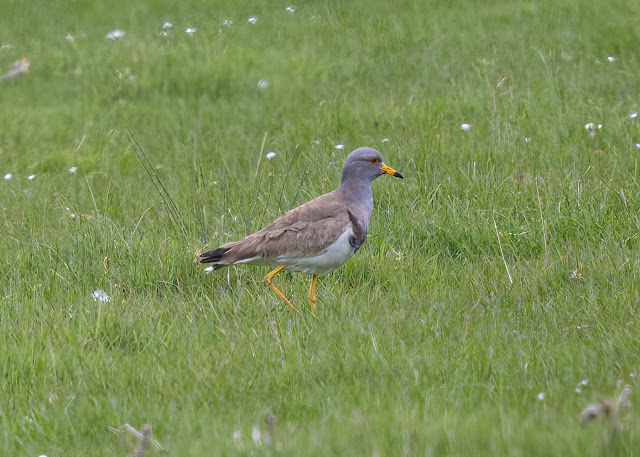We were out walking our dogs yesterday morning when I said to my every suffering wife that May was a top month for rarities. We had just got home and I was making coffee when I picked up on our twitching WhatsApp group that a Grey-headed Lapwing had been found near the Scottish border in Northumberland! This would be the first UK record of this Asian Lapwing and only the 4th in the whole of the western palearctic.
So after a very quick coffee I was in the car and off on the 285 mile trip to Newton-by-the-Sea. It was a mainly boring motorway drive punctuated by a few nervous stops to make sure the bird was still there – a passing raptor could be enough to spook it and make it depart!
The excellent “twitching the UK group” was providing good updates on the traffic conditions, parking and the bird on route and I arrived at 16:00 and found a space to park amongst the many cars. Walking towards the birds location is always notable for the relaxed birders chatting on route back and the nervous hurrying birders on their way praying that the bird stays put.
Newton-by the sea turned out to be a beautiful and quintessential old English fishing port with delightful stone cottages. The Lapwing was located in a grass field adjacent to a small wetland scrape and access was being allowed into the cottage parking area so the bird could be viewed.
As this point I need to say a massive thank you to the finders Gary Woodburn and Richard Lowe for putting the news out so quickly. I read on twitter that this was their local patch and that they had put the scrape in themselves
Of the four palearctic records of this Asian wader the closest to the UK was in Holland in 2019, a record which I understand has been accepted by the Dutch rare birds committee. The first record was on 11 May 2018 in the Kizilirmak Delta in Northern Turkey and the second record was of a bird seen on 2-4 May 2019 at Mose, Arendal, Norway and subsequently between 13 and 19 May 2019 at Strandvik, Hultsberg, Sweden. It should be noted that these birds are rarely, if ever, kept in captivity in Europe so an escape seems highly unlikely.
Now this is one truly lost bird! It should be heading towards northeast China or Japan where they breed. The Chinese population winters from north-eastern India to Cambodia while the Japanese population winters mainly in southern Honshu.
In appearance it is an attractive bird with a grey head and neck, darker grey breast band and white belly. The back is brown, the rump is white and the tail is black. It is a striking species in flight, with black primaries, white under wings and upper wing secondaries, and brown upper wing coverts.
The lapwing was 100 meters or so away from the viewing point in the grass field with, thankfully, no opportunity for any clown to try and get closer and spook the bird. It looked in good health and was very settled feeding on worms and other invertebrates in the grass. A couple of times it flexed its wings showing the attractive flight features mentioned above.
I spent a most enjoyable couple of hours watching the bird in my scope, taking record shots, trying out some phone scoping and chatting to a few familiar face before I reluctantly pulled myself away for the 285 mile journey home.
Truly remarkably, I have now had 7 new UK tick this year, perhaps what I might have hoped for but certainly not what I expected!
Footnote – my blogs are posted with sometimes rather imaginative spelling and grammar due to my extreme dyslexia!




What a fantastic find! AND you got excellent photos.
ReplyDelete